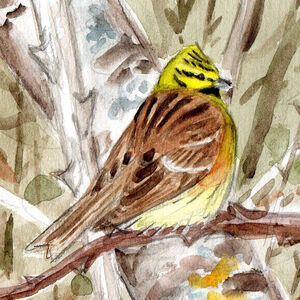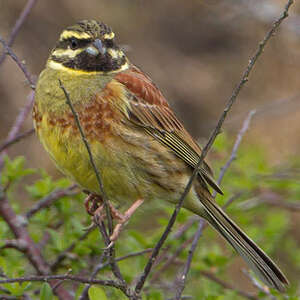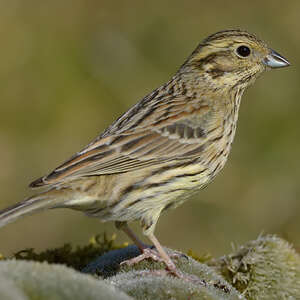Cirl Bunting
Emberiza cirlus - Bruant zizi
Identification
The male Cirl Bunting looks superficially similar to the Yellow Bunting. The confusion may come especially from females and juveniles. It is a bit smaller with a shorter tail. The nuptial male obviously stands out from behind due to its very chestnut-colored upper parts (coat, covers and tertiaries) and the absence of a vivid red in the rump which is olive gray. Seen from the front, the most striking thing is the pattern of the head and chest. The first is very contrasted with a succession of dark stripes (gray cap striped with black, black lore, blackish auricular covers and black throat) and two yellow stripes interposed framing the dark orbital band. A white spot is visible at the back of the parotic. The chest has a wide olive plastron topped with a yellow collar and framed by two large chestnut patches reaching up to the wrists. The belly is yellow and the flanks slightly striped. The beak is two-tone, black above and grayish blue below. The two outer pairs of rectrices have white, clearly visible only in flight or during grooming, in their internal vexil. The female looks like the male but less colored. It stands out quite easily from the female of the Yellow Bunting thanks to its chestnut covers, its gray-brown rump, the head and chest patterns identical to those of the male but less marked and less colored. The plumage is more striped and the throat is white. The juvenile is like a dull female. The chestnut of the wings remains remarkable. Compared to the young B. jaune, the head pattern is clear. The chest and flanks are more clearly and finely striped with brown. And of course, let's not forget that the two species have very different cries.
Subspecific information monotypic species
Foreign names
- Bruant zizi,
- Escribano soteño,
- escrevedeira-de-garganta-preta,
- Zaunammer,
- sövénysármány,
- Cirlgors,
- Zigolo nero,
- häcksparv,
- Hekkspurv,
- strnádka svrčivá,
- strnad cvrčivý,
- Gærdeværling,
- pensassirkku,
- gratapalles,
- Álmtittlingur,
- cierlik,
- žogu stērste,
- plotni strnad,
- Огородная овсянка,
- ノドグロアオジ,
- 黄道眉鹀,
- häcksparv,
- 黃道眉鵐,
Voice song and call
The usual call is a sharp, penetrating siii. It is a contact call. When they are active and mobile, the cries are soft and sharp, tsit, sit, tit, titit, and variations of such. The song is a fast sequence of ringing notes that lasts for 2-3 seconds which can be described as a trill. The rhythm is consistent but, depending on the singer, the pitch of the notes varies. Some are dry and metallic while others can be described as liquid.
Habitat
The Cirl Bunting seeks out traditional, varied and low-pressure anthropogenic environments (agricultural plots with uncultivated margins, gardens, vineyards, meadows, etc.
Behaviour character trait
The Cirl Bunting is quieter than its cousin the Yellow Bunting and, though it occasionally sings from the top of a tree, wire or television antenna, it usually stays hidden by the foliage and the observer must be content with its voice. Despite this apparent timidity, it willingly mixes with groups of finches and other seedeaters during the interseason in its search for food.
Flight
Dietfeeding habits
The Cirl Bunting is mainly granivorous, especially seeking out seeds of poaceae and by extension cereals, on the ground. Many other seeds are also part of its diet. In the good season, couples look for their food together. Young birds are fed a range of insects, more nutritious than seeds. In winter, the birds feed with other granivores in fields and open areas, but never too far from their woody refuge.
Reproduction nesting
The Cirl Bunting is a resident bird whose breeding season extends from late March to August, longer of course in the south than in the north.
There are usually two nests in the spring, but a third can potentially take place in July- August. The nest is built at a low height (generally less than 1.5 meters) well hidden in a dense shrub, thorny or coniferous, or even in a climbing plant, for example a ivy. The male invites the female to start working by walking around with some blades of grass in its beak, but it is the female who takes care of the whole work. The nest is a rather coarse bunch of stems, dry grass and moss protecting a neat cup made of fibers, rootlets and hairs. The laying consists of 3 to 4 eggs (2 to 5) grayish stained with light brown and highlighted with black drawings. The female takes care of the incubation for 11 to 13 days. The young, fed by both adults, fly away at 14 days.Geographic range
The Cirl Bunting is a sedentary southern species, inhabiting the countries bordering on the Mediterranean, except for the south-east and east where the habitats are too arid. It also occupies the Mediterranean islands. It is at the edge of its range in the north of France and there are few presence points in the Benelux and Germany. The same applies further east, but at lower latitudes due to the more continental climate. It is thus very rare in Austria, Hungary and Romania. It is present in the south of England and in Wales. It can be assumed that the current climate change could favour it at the north of its range.
Threats - protection
IUCN conservation status
concern
in the Wild
threatened
evaluated
The Cirl Bunting is not threatened. It has seen highs and lows, but its population is currently estimated to be stable. Its presence is more fragile on the edges of its range, and localized disappearances are possible. The case of England is interesting. The species was once widespread in the south of the country and in Wales, but has since declined sharply and would have disappeared without the measures taken, primarily regarding habitat, which have gradually restored the population. The threats are known: it is the changes that affect its traditional semi-open habitat, either because of too much human pressure (loss of plant diversity, intensive land use, urbanization...) or, on the contrary, because of a lack of management that leads to the closure of the environment by the development of woody plants, which limits access to the ground.
Sources of information
- IOC World Bird List (v15.1), Gill, F and D Donsker (Eds). 2025-12-07.
- Les passereaux d'Europe, tome 2, P. Géroudet, M. Cuisin
- Birds of the World, The Cornell Lab of Ornithology
- xeno-canto, Sharing bird sounds from around the world,
Other sources of interest
 Specification sheet created on
16/07/2023 by Jean François
Specification sheet created on
16/07/2023 by Jean FrançoisTranslation by AI Oiseaux.net
© 1996-2026 Oiseaux.net
- Accipitriformes
- Aegotheliformes
- Anseriformes
- Apodiformes
- Apterygiformes
- Bucerotiformes
- Caprimulgiformes
- Cariamiformes
- Casuariiformes
- Charadriiformes
- Ciconiiformes
- Coliiformes
- Columbiformes
- Coraciiformes
- Cuculiformes
- Eurypygiformes
- Falconiformes
- Galliformes
- Gaviiformes
- Gruiformes
- Leptosomiformes
- Mesitornithiformes
- Musophagiformes
- Nyctibiiformes
- Opisthocomiformes
- Otidiformes
- Passeriformes
- Pelecaniformes
- Phaethontiformes
- Phoenicopteriformes
- Piciformes
- Podargiformes
- Podicipediformes
- Procellariiformes
- Psittaciformes
- Pterocliformes
- Rheiformes
- Sphenisciformes
- Steatornithiformes
- Strigiformes
- Struthioniformes
- Suliformes
- Tinamiformes
- Trogoniformes
































